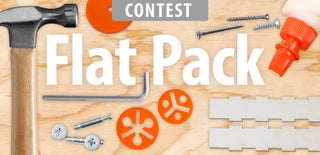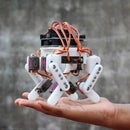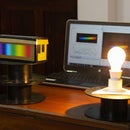Introduction: Flat Pack Table-tennis Table!
Table tennis is a great game to play anytime anywhere! However because of the table being cumbersome it is pretty difficult to move it around. Therefore we have made a portable table tennis table, in other words completely flat pack. That's not all, the whole ping pong table is made out of cardboard using no glue, no tape, only interlocking systems and flaps. That's the beauty of it because we didn't use any adhesives you can easily dismantle and put it together very quickly anytime, anywhere!
If you like this INSTRUCTABLES please vote for it in the contest, any questions or feedbacks will be happily replied in the comments section below.
Step 1: Material Needed
MATERIAL NEEDED :
- CARDBOARD (a lot of it, a rough estimation 5 sheets of 1 by 2 meters. An important point to keep in mind, try to be as careful as possible with the cardboard because bends might effect the outcome )
EXTRAS :
- Masking tape
- A ping pong ball (yup that's not out of cardboard :)
TOOLS :
- X-acto knife
- A pair of scissors
Step 2: Getting the Various Parts Ready
Here are all the pieces to make the table tennis table. Print outs would be to big so you will have to draw them on the cardboard directly. I have marked out the dimensions to all the pieces. i have used a color code to make it easier : Blue = the dimensions of the piece; Red = indicates where the slits are and its dimensions; and Black (dotted)= are where the folds need to come. I have named the pieces so that it is easier to communicate which piece i am talking about. Here are the list of pieces: Ax2, A1x2(they both share the same dimensions other then the flap in A1), Bx2, Cx2, Dx2, Ex2, Fx1.
Step 3: Cutting Them Out...
Draw the pieces in the most efficient way saving as much carboard as possible. After you are satisfied with the placement, you can then cut the pieces in their rough sizes with an x-acto knife and then precisely cut it with your pair of scissors.
TIP : when cutting with scissors only cut along the corrugated line because the other way damages the first layer of the cardboard. Although you will be requiring the scissors not too much because most of the templates have straight lines easily cuttable with the x-acto knife.
Step 4: THE STRUCTURE
The first step is to make the cross-section beams on which the body rests. To do that start by taking the pieces ''A'' , ''A1'' and ''B'' and cut out the slits (the red lines). Once done fold the piece where the dotted line is. To make the cardboard fold easily score the cardboard by applying very slight pressure with your x-acto knife. Now fold where the requirements are.It's time to start interlocking them. place the two ''B'' pieces parallel to each other and then match both ''A/A1'' and ''B'' slits so that they fit into each other. You should end up with something like in the pictures. Make sure that ''A1'' is placed on the outer end with the flap facing out.
Step 5: THE TABLE TOP
Now that we have our structure lets put the table top. Make all the needed slits and folds and then place the two ''C'' sections under the structure.(so that the ''B'' beams are facing up, 2nd picture). Then fold the flaps so that they interlock with the side of the cross-sections. Then tuck in the flaps in their slits, two in ''B'' and one from ''A1'' into ''C''. Do it for the other side and you should end up with a nice and sturdy ''table''. This step is a little tricky but however the picture should remove your doubts! Time for the base.
Step 6: THE BASE
Get the pieces ready.Then insert the 10cm flap piece ''D'' into the piece ''E''. Now place ''E'' so that it fits into ''A''. do it on both sides. Finally you will find a last slit where the smaller flap of ''D'' gets in. Attach that and now you have a standing table. The pictures will help.
Step 7: CARDBOARD GRIPPER
I saw that the table top was tending to get loose so i came up with this gripper which does the job.
Step 8: NET, RAQUET AND SOME ADDED FEATURES!
Now for the final touches. Once you have your net piece cut out you can draw the net with a black pen to give it some life. Then i went on to make a raquet out of cardboard by just simply tracing an actual table tennis raquet on some cardboard( it was pretty amazing however after several games it was beginning to bend). With some making tape I made the white lines. The whole thing suddenly came to life and it was finally time to try it out!
Step 9: SUCCESSFUL!!!
Conclusion:
I am very happy with how it turned out. It is just what flat pack is about, everything fits perfectly in an easy to carry suitcase and it hardly takes five to ten minutes to assemble and disassemble. The great thing is I kind finally play table tennis anywhere and whenever i want, now the kit easily fits through the door and five minutes of assembling and I have my very own table tennis table in my room!
However a normal table tennis ball bounces but not very well on the cardboard, but a great alternative is a rubber ball.
Hope you enjoyed the instructables!

Participated in the
Flat Pack Contest













